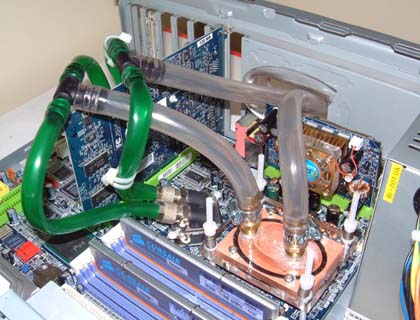What?
A water-cooled (and virtually silent) PCWhen?
Mid 2002 to early 2004, in stagesWhy?
The sweet sound of silenceHow?
There comes a time in every computer enthusiast's life when you sit down, take stock, and think "what's that bl**dy racket?". And the answer, of course, is all the crappy little fans attached to nice acoustically transmissive surfaces inside your PC. Once you have this epiphany, despite many hours of training in doublethink, it is impossible to un-learn the fact that the box sitting next to you is really, irritatingly, noisy. Generally speaking, noise is a distraction. It's also a tell-tale sign of how inelegant the mechanical engineering of most PCs is; those little whirry fans could have been replaced with slower, larger fans with a tiny, tiny little bit more money (and/or thought).So, having become thoroughly annoyed with something that's supposed to make life easier, I resolved to do something about it. Ever since I was young, I've always though that liquid-cooled computers were a good idea. You get much greater thermal efficiency, near-absolute silence and the slightly disconcerting (but very cool) sight of tubes of liquid intertwined with the rest of the cables coming out of the back of the box. Of course, water cooling still isn't exactly mainstream, and back when I started this project, it was even more niche than it is now. So finding parts would prove to be something of a chore. I knew that cooling blocks (to attach to chips, etc.) were readily available, and my local aquarium stockist was happy (and slightly puzzled) to supply a nice Eheim pump and some silicone rubber tubing. The part which caused most concern was the radiator.
Some radiators were available for order, and other people had reported success using motorcycle radiators or car heat-exchangers. However, the thing all these units had in common was the need for forced induction to dissipate sensible amounts of heat. Now, I'm a big fan of forced induction (provided it's done properly), but not when it comes to keeping things quiet. So, having done some quick back-of-the-envelope calculations, I decided to build my own radiator. Not just any old radiator, either, but one designed to dissipate 150 Watts of heat using only natural convection.
Fortunately, if you're prepared to trade off space for efficiency, this is quite possible. I was quite happy with the idea of keeping the radiator under the desk, and the calculations showed that the surface area required would not be too large. So, having ordered some copper sheet and heavy-duty tin snips from Farnell, I began construction. The basic architecture is two coils of 8mm copper tubing, formed into shape around a bottle of M&S Bucks Fizz (well you wouldn't want to drink the stuff, so it may as well be useful as a radiator tool...). The coils are were then joined together top and bottom using a compression-fitting T-piece.
To give the structure some stability, four legs were attached and soldered the length of the coils to keep them rigid. From here, it was straightforwads (but hot, painful and tedious) to attach several square metres of carefully cut copper sheet to the coils to ensure high enough thermal dissipation. Initial testing showed up no leaks, so the tubes for the rest of the system were attached: the pump drives water through the CPU, graphics and motherboard cooler blocks, then a return runs to the top of the radiator and finally out of the bttom of the radiator and back to the pump.
Once this was all plumbed together, the cooling system ran with the barest hum from the aquarium pump, and no other noise - beautiful! What's more, even whilst cooling a GeForce 2 and 1.4GHz AMD Athlon, the water in the system never rises more than 10 degrees above ambient temperature - providing lower on-chip temperatures than even the best fan coolers.
The computer was upgraded around the start of 2004, and now runs with an even hotter GeForce 4 and Intel Pentium 4 (which required a new cooler block). Pleasantly, the water temperature still stays within 12 degrees (Celsius, infidels) of the room. Nifty.


